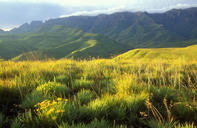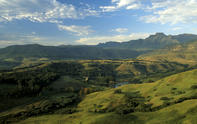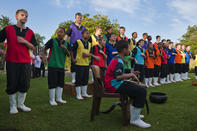The First People
The first people we know of to have inhabited the valleys round the base of Mdedelelo in the Drakensberg were Bushmen, then the amaZizi, who were scattered during the reigns of terror in the early 1820s.

A decade later the Voortrekkers arrived and established some farms, but they moved on when the British Empire started muscling in. The first British settler in the Champagne Valley was David Gray in 1858 who farmed Cathkin.
Then, as the Dire Straits song 'Telegraph Road' goes, came the woodcutters and hunters: Nelson at Cathkin, Van Greuning at Injisuthi, Kruger at Makururnan, as well as various recluses and runaways. One of them was 'Old Man' Hodgson who lived with his dogs in a mud hut in the Injisuthi Valley (the name means 'well-fed dogs') and sold the Zulu busts he modelled in clay to hotel guests. He had been an officer in the British Army.
In 1907 an etymologist named Dr Haviland set off from Couch and de Bath's store (now White Mountain Inn) at Ntabanlope, midway between Giant's and Champagne castles, on his bicycle. The good doctor was never seen again, but his bicycle was found a decade later in a cave about 10 kilometres away. In 1942 a skeleton with 40 golden sovereigns in what remained of a pocket was found by hikers on the slopes of Cathkin Peak. The good doctor, perhaps?
Bit of History
Of course there has to be an Irishman in our story. In this case two brothers of the name McCormick who were banished from Ireland for being Sinn Feiners. They lived in a cave above the kwaNdema Stream in the Drakensberg and lived the life of 'bushrangers' - that is, cattle rustlers. The story is still told in the kraals of the valleys around here of a battle between a Zulu regiment and Bushman cattle thieves.
Apparently the little hunters were trapped on a high slope somewhere above the Nkosana River. There are no passes here, so near the summit they made an extraordinary last stand. They lay on their backs, put their feet into leather thongs tied round their bow staves, and using both hands to pull the strings let fly bursts of poisoned arrows almost vertically upwards which then rained down on the pursuers.
The Zulu detail were so terrified of the poisoned barbs they retreated, and in the ensuing darkness the Bushmen found a way over into Lesotho and a short-lived freedom. To my mind the most eccentric bit of history involves a 'gold' rush in the upper Nkosana Valley. In the 1920s a local farmer broke the news that he'd found cinnabar (red mercuric oxide from which mercury is derived) in the Drakensberg.
For several months the upper Nkosana Valley, where the purplish-red layers of the Red beds are exposed, rang with the sound of men and picks. Today you can still see the scars of the paths they wore and the holes they dug. But it was a foolish hoax.
The Craze of Drakensberg Tourism

Today Champagne Valley is the most highly developed area of the Drakensberg, because the Sterkspruit/Mpofana Valley is so easily travelled. first hotel was Cathkin Park. It was started by W Carter Robinson in 1929 as a hostel. It was he who stocked the local rivers with brown trout and pushed to have Monk's Cowl forest reserve proclaimed. It was taken over by Otto Zunckel in 1935, and run by his two sons Udo and Gerald.
While under the management of Gerald's nephew Anton (now at Bushman's Nek Hotel) it was absorbed by the Drakensberg Sun. Next came Oom Hendrik Maartens who had catered for a few mountain club July camps and became enamoured with the new craze of tourism. In 1940 he bought the farm Woestyn and erected the first buildings which were to become Champagne Castle Hotel. In 1943 he sold to J van Heynigen, whom we will meet later on the Contour Path from Cathedral.
Sound of Music
In 1940 Captain HC Whelan bought the farm Heartsease and built El Mirador Hotel. Then came David Gray, grandson of the original David Gray in the area, who turned the farmstead on his property The Nest into the one which perhaps best of all retains the charms of the family hotels of yesteryear. In 1954 the then news editor of the Natal Daily News, RW Tungay, bought Dragon Peaks farm and turned it into a caravan park resort.
He and his son John had a dream, and today the hills ring with the sound of music from the Drakensberg Boy's Choir, the school started on land next door. Also in the valley are Mountain Splendour Eco-Resort on the other side of the road to Dragon Peaks, the Champagne Sports Resort part-owned by tennis ace Kevin Curren, Ardmore Guest Farm which boasts beautiful views and fishing, mountain biking and walking amongst its attractions, and then the very basic Kelvin Grove Camp Site.
For back-packers and hikers the preferred place to stay is my old mate Ed Salomon's place, Inkosana Lodge and Trekking. It's informal and caters for couples or groups, bed and breakfast or full board. Ed is the local magistrate when needs be, but he's also an experienced mountaineer from Monk's Cowl to the Himalayas.
Drakensberg Boy's Choir
